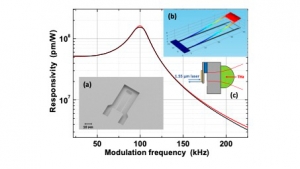A new Terahertz (THz) radiation detector has been demonstrated within the THz Photonics team of the IEMN, in collaboration with the startup Vmicro, a spin-off of the same laboratory.
Fig. 1 The graph shows the frequency response of the detector, measured with a quantum cascade laser at 2.5 THz, modulated in amplitude (black curve). The red curve is the result of a fit from an analytical model. (a) Scanning Electron Microscopy picture of the detector entirely realized on a Silicon-on-Insulator (SOI) platform. One can distinguish the U-shaped suspended microlever. (b) Simulation of the 1st out-of-plane bending mode excited by the incident THz radiation. (c) Cross-section of the detector. The incident THz radiation is focused on the antennas by a hyper-hemispheric lens (green) in contact with the substrate (grey). The laser beam for the optical reading at 1.55µm is reflected by the end of the microlever [1].
The THz range cruelly lacks detectors operating at room temperature that are both sensitive and fast. The detectors currently on the market, such as thermopiles, pyroelectric detectors, or silicon bolometers have response times typically ranging from 10 to 100ms, which makes them difficult or impossible to use for many applications, such as gas detection or spectroscopy, near-field imaging etc.
In an attempt to fill this gap, researchers from the THz Photonics team, in collaboration with Vmicro staff, have designed, realized and characterized a new type of detector consisting of a silicon microlevier of only 40mm length and 10mm width. As shown in Fig.1(a),(b), the microlevier takes the shape of a « U ». On both arms a thin layer of gold is deposited, which forms two dipole antennas, thus able to collect and absorb the incident THz radiation. As a result the THz radiation is transformed into heat by Joule effect in the metal layers. Because of the difference between the thermal expansion coefficients of gold and silicon, this heating produces an out-of-plane bending of the microlever, as illustrated in Fig.1(b) (this effect is known as « bilame effect »). The latter is finally read optically, thanks to a 1550 nm laser beam which is reflected by the end of the microlevier and directed towards a detection system sensitive to the beam displacement (Fig.1(c)). Due to its extremely small size, the thermal time constant of the microlever is in the order of microseconds, which determines the response time of the detector. The frequency response shown in Fig.1 is the experimental proof.
A new type of detector, both sensitive (NEP ~ 10nW/Hz^1/2) and 4 to 5 orders of magnitude faster compared to commercially available detectors has been demonstrated. Moreover, this detector is entirely realized on a SOI platform, thus compatible with CMOS (Complementary Metal Oxide Semiconductor) microelectronics, which could, in the future, allow the realization of a completely integrated reading system.
These results were published in the journal Applied Physics Letters [1].
[1] K. Froberegr at el., SOI-based micro-mechanical terahertz detector operating at room-temperature and atmospheric pressure, Appl. Phys. Lett. 120, 261103 (2022); doi:10.1063/5.0095126














